Automatic Transmission Fluid -- Adjustment |
| 1. BEFORE FILLING TRANSMISSION |
- The AE80F automatic transmission assembly requires Toyota Genuine ATF WS.
- If the entire automatic transmission assembly, automatic transmission oil pan sub-assembly, transmission oil pan tube (drain plug), transmission valve body assembly and/or torque converter assembly have/has been replaced, proceed to the Fill Transmission procedure.
- If the transfer adapter oil seal has been replaced and/or an automatic transmission fluid leak has been replaced, proceed to the Adjust Fluid Temperature procedure.
| 2. REMOVE NO. 2 ENGINE UNDER COVER |
Remove the 2 bolts and No. 2 engine under cover.
 |
| 3. REMOVE OIL PAN PROTECTOR ASSEMBLY |
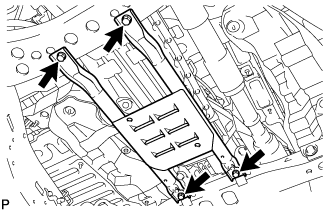 |
Remove the 4 bolts and oil pan protector assembly.
| 4. REMOVE TRANSMISSION CASE COVER (w/ Cover) |
Remove the 3 bolts and transmission case cover.
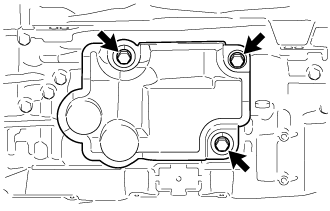 |
| 5. FILL TRANSMISSION PAN WITH FLUID |
Lift the vehicle.
- NOTICE:
- Set the vehicle on a lift so that the vehicle is kept level when it is lifted up (make sure that the tilt angle from the front to rear of the vehicle is within +/-1°).
Remove the refill plug and O-ring from the automatic transmission assembly.
 |
Using a 5 mm hexagon socket wrench, remove the overflow plug and gasket from the automatic transmission assembly.
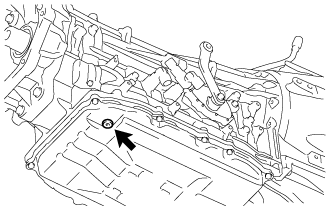 |
Add automatic transmission fluid to the refill hole until it flows out of the overflow hole.
Text in Illustration *a Refill Hole *b Overflow Hole - NOTICE:
- Use Toyota Genuine ATF WS.
- Be sure to add automatic transmission fluid slowly. If automatic transmission fluid is added quickly, the automatic transmission fluid may hit internal parts and bounce back, resulting in automatic transmission fluid coming out of the refill hole.
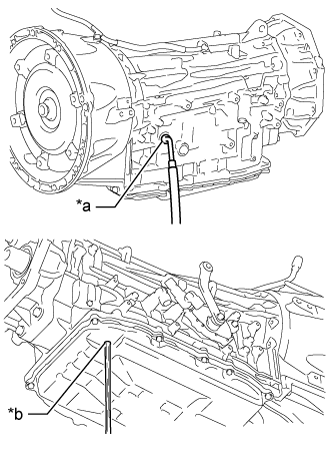 |
Wait until the automatic transmission fluid flow slows and only drips come out.
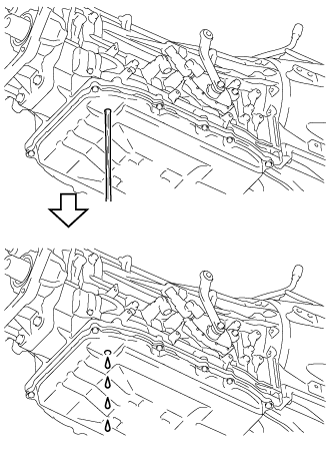 |
Using a 5 mm hexagon socket wrench, temporarily install the overflow plug and gasket to the automatic transmission assembly.
- HINT:
- Reuse the old gasket as the overflow plug will be removed again.
 |
| 6. FILL TRANSMISSION |
Fill the automatic transmission assembly with the correct amount of automatic transmission fluid as listed in the table below.
- Standard Capacity:
Performed Repair Fill Amount Removal and installation of the automatic transmission oil pan sub-assembly 2.7 liters (2.9 US qts, 2.4 Imp. qts) Removal and installation of the transmission valve body assembly 3.6 liters (3.8 US qts, 3.2 Imp. qts) Removal and installation of the torque converter assembly
(Including the oil drain)5.3 liters (5.6 US qts, 4.7 Imp. qts)
- HINT:
- If the specified amount of automatic transmission fluid cannot be added, perform the following:
Temporarily install the O-ring and refill plug to the automatic transmission assembly.
- HINT:
- Reuse the old O-ring as the refill plug will be removed again.
Lower the vehicle.
Depress and hold the brake pedal.
Start the engine.
- NOTICE:
- To reduce load, make sure that all electrical systems, such as the air conditioning, lighting system, electric fan and audio system, are off.
Slowly move the shift lever from P to D, then move the shift lever to P.
- HINT:
- Keep the shift lever in each position for approximately 3 seconds.
Allow the engine to idle for 30 seconds to warm it up.
Turn the engine switch off.
Remove the refill plug and O-ring from the automatic transmission assembly.
Fill the automatic transmission assembly with the correct amount of automatic transmission fluid as listed in the table above.
Temporarily install the O-ring and refill plug to the automatic transmission assembly.
- HINT:
- Reuse the old O-ring as the refill plug will be removed again.

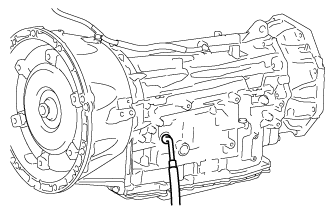 |
| 7. ADJUST FLUID TEMPERATURE |
- NOTICE:
- The automatic transmission fluid temperature can be confirmed by checking the D shift indicator on the combination meter or using the GTS. When not using the GTS, it is necessary to enter automatic transmission fluid temperature detection mode.
When using the GTS:
- HINT:
- The actual ATF temperature can be checked on the Data List using the GTS.
Connect the GTS to the DLC3 with the engine switch off.
Turn the engine switch on (IG) and turn the GTS on.
- NOTICE:
- To reduce load, make sure that all electrical systems, such as the air conditioning, lighting system, electric fan and audio system are off.
Enter the following item: Powertrain / ECT / Active Test / Connect the TC and TE1.
Select the Active Test item: Connect the TC and TE1 / ON.
Select the Data List item: A/T Oil Temperature 1.
Check the ATF temperature.
- NOTICE:
- If the automatic transmission fluid temperature is below 46°C (115°F), proceed to the next step. (Recommended ATF temperature: 39°C (102°F) or less)
- If the automatic transmission fluid temperature is 46°C (115°F) or more, turn the engine switch off and wait until the automatic transmission fluid temperature drops below 39°C (102°F).
Depress and hold the brake pedal.
Start the engine.
- NOTICE:
- To reduce load, make sure that all electrical systems, such as the air conditioning, lighting system, electric fan and audio system, are off.
Slowly move the shift lever from P to D, then move the shift lever to P.
- HINT:
- Keep the shift lever in each position for approximately 3 seconds.
While observing the D shift indicator on the combination meter, move the shift lever back and forth between N and D at an interval of less than 1.5 seconds for 6 seconds or more.
- NOTICE:
- Do not pause for more than 1.5 seconds.
- HINT:
- Performing this operation will cause the vehicle to enter automatic transmission fluid temperature detection mode.
Check that the D shift indicator turns off for 2 seconds.
- HINT:
- When automatic transmission fluid temperature detection mode is activated, the D shift indicator on the combination meter will turn off for 2 seconds.
- If the D shift indicator on the combination meter does not turn off for 2 seconds, return to the first step and perform the procedure again.
Move the shift lever from N to P.
Release the brake pedal.
Select the Active Test item: Connect the TC and TE1 / OFF.
- NOTICE:
- Make sure that terminals TC and TE1 are not connected. If the terminals are connected, the automatic transmission fluid level cannot be precisely adjusted due to fluctuations in engine speed.
- HINT:
- Disconnecting terminals TC and TE1 activates engine idle speed control mode.
- Even after terminals TC and TE1 are disconnected, automatic transmission fluid temperature detection mode will be active until the engine switch is turned off.
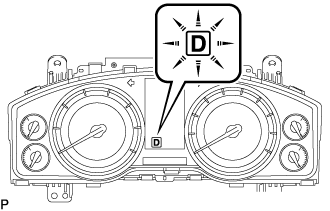
When not using the GTS:
Using SST, connect terminals 13 (TC) and 4 (CG) of the DLC3 with the engine switch off.
- SST
- 09843-18040
Text in Illustration *a Front View of DLC3 Depress and hold the brake pedal.
Start the engine.
- NOTICE:
- To reduce load, make sure that all electrical systems, such as the air conditioning, lighting system, electric fan and audio system, are off.
- HINT:
- The indicator lights on the combination meter blink to indicate DTCs when terminals TC and CG are connected.
Slowly move the shift lever from P to D, then move the shift lever to P.
- HINT:
- Keep the shift lever in each position for approximately 3 seconds.
While observing the D shift indicator on the combination meter, move the shift lever back and forth between N and D at an interval of less than 1.5 seconds for 6 seconds or more.
- NOTICE:
- Do not pause for more than 1.5 seconds.
- HINT:
- Performing this operation will cause the vehicle to enter automatic transmission fluid temperature detection mode.
Check that the D shift indicator turns off for 2 seconds.
- HINT:
- When automatic transmission fluid temperature detection mode is activated, the D shift indicator on the combination meter will turn off for 2 seconds.
- If the D shift indicator on the combination meter does not turn off for 2 seconds, return to the first step and perform the procedure again.
Move the shift lever from N to P.
Release the brake pedal.
Remove SST from terminals 13 (TC) and 4 (CG).
- SST
- 09843-18040
Text in Illustration *a Front View of DLC3 - NOTICE:
- Be sure that terminals TC and CG are not connected. If the terminals are connected, the automatic transmission fluid level cannot be precisely adjusted due to fluctuations in engine speed.
- HINT:
- Disconnecting terminals TC and CG activates the engine idle speed control mode.
- Even after terminals TC and CG are disconnected, automatic transmission fluid temperature detection mode will be active until the engine switch is turned off.
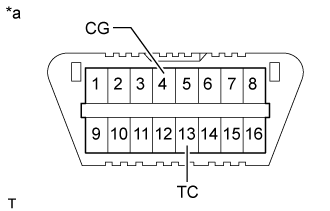


Allow the engine to idle until the automatic transmission fluid temperature reaches 35 to 45°C (95 to 113°F).
The D shift indicator will come on again when the automatic transmission fluid temperature reaches 35°C (95°F) and will blink when it exceeds 45°C (113°F).
- HINT:
- Adjust the automatic transmission fluid level when the D shift position indicator is illuminated.
- If the D shift position indicator is not illuminated, idle the engine to warm it up until the D shift position indicator illuminates.
- If the D shift position indicator is illuminated, immediately begin to adjust the automatic transmission fluid level.
- If the D shift position indicator is blinking, stop the engine to cool the automatic transmission fluid. Once the automatic transmission fluid temperature drops to the appropriate level, perform the automatic transmission fluid level adjustment procedure again.
- D Shift Indicator :
Below Automatic Transmission Fluid Level Adjustment Temperature
(39°C or less)
(102°F or less)Automatic Transmission Fluid Level Adjustment Temperature
(39 to 46°C)
(102 to 115°F)Above Automatic Transmission Fluid Level Adjustment Temperature
(46°C or more)
(115°F or more)OFF ON Blinks
| 8. CHECK FLUID LEVEL |
- CAUTION:
- Use caution while the engine is idling and the radiator fan is operating.
Lift the vehicle.
- NOTICE:
- Set the vehicle on a lift so that the vehicle is kept level when it is lifted up (make sure that the tilt angle from the front to rear of the vehicle is within +/-1°).
Using a 5 mm hexagon socket wrench, remove the overflow plug and gasket from the automatic transmission assembly.
- CAUTION:
- Be careful as the automatic transmission fluid coming out of the overflow hole is hot.
 |
Check the amount of automatic transmission fluid that comes out of the overflow hole.
- If the amount of automatic transmission fluid that comes out of the overflow hole is large, proceed to step [*1].
- If no automatic transmission fluid comes out of the overflow hole, proceed to step [*2].
- NOTICE:
- If only a small amount of automatic transmission fluid (approximately 5 cc) comes out of the overflow hole, then only automatic transmission fluid remaining in the transmission oil pan tube has come out. This is not considered to be overflow.
- If the amount of automatic transmission fluid that comes out of the overflow hole is large, proceed to step [*1].
If the amount of automatic transmission fluid that comes out of the overflow hole is large, wait until the automatic transmission fluid flow slows and only drips come out. [*1]
- HINT:
- The automatic transmission fluid flow will not stop completely because the automatic transmission fluid continues to expand as its temperature increases.
 |
If no automatic transmission fluid comes out of the overflow hole, remove the refill plug and O-ring. Then add automatic transmission fluid to the refill hole until it flows out of the overflow hole. Wait until the automatic transmission fluid flow slows and only drips come out. [*2]
Text in Illustration *a Refill Hole *b Overflow Hole - NOTICE:
- Use Toyota Genuine ATF WS.
- Be sure to add automatic transmission fluid slowly. If automatic transmission fluid is added quickly, the automatic transmission fluid may hit internal parts and bounce back, resulting in automatic transmission fluid coming out of the refill hole.
 |
Wait until the automatic transmission fluid flow slows and only drips come out.
- HINT:
- The automatic transmission fluid flow will not stop completely because the automatic transmission fluid continues to expand as its temperature increases.
 |
Using a 5 mm hexagon socket wrench, install a new gasket and the overflow plug to the automatic transmission assembly.
- Torque:
- 16 N*m{163 kgf*cm, 12 ft.*lbf}
Install a new O-ring and the refill plug to the automatic transmission assembly.
- Torque:
- 39 N*m{400 kgf*cm, 29 ft.*lbf}
Lower the vehicle.
Turn the engine switch off.
- HINT:
- Turning the engine switch off exits automatic transmission fluid temperature detection mode.
Disconnect the GTS from the DLC3 (when using the GTS).
| 9. INSTALL TRANSMISSION CASE COVER (w/ Cover) |
Install the transmission case cover with the 3 bolts.
- Torque:
- 13 N*m{131 kgf*cm, 9 ft.*lbf}
| 10. INSTALL OIL PAN PROTECTOR ASSEMBLY |
Install the oil pan protector with the 4 bolts.
- Torque:
- 50 N*m{510 kgf*cm, 37 ft.*lbf}
 |
| 11. INSTALL NO. 2 ENGINE UNDER COVER |
Install the No. 2 engine under cover with the 2 bolts.
- Torque:
- 29 N*m{296 kgf*cm, 21 ft.*lbf}
| 12. AFTER FILLING TRANSMISSION |
Lift the vehicle.
Clean each part.
Check for automatic transmission fluid leaks.
Lower the vehicle.
| 13. ATF THERMAL DEGRADATION ESTIMATE RESET |
- HINT:
- Approximately 50% or more of the ATF has been replaced during a repair of the transmission or a similar operation (Click here)